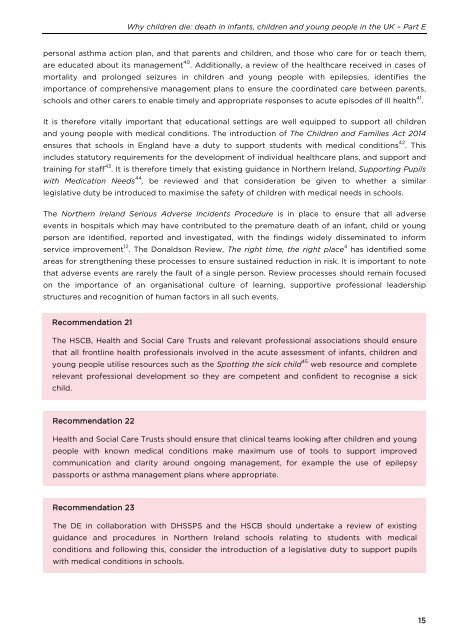Why children die death in infants children and young people in the UK Part E
PART E Why Children Die Northern Ireland web
PART E Why Children Die Northern Ireland web
You also want an ePaper? Increase the reach of your titles
YUMPU automatically turns print PDFs into web optimized ePapers that Google loves.
<strong>Why</strong> <strong>children</strong> <strong>die</strong>: <strong>death</strong> <strong>in</strong> <strong>in</strong>fants, <strong>children</strong> <strong>and</strong> <strong>young</strong> <strong>people</strong> <strong>in</strong> <strong>the</strong> <strong>UK</strong> – <strong>Part</strong> E<br />
personal asthma action plan, <strong>and</strong> that parents <strong>and</strong> <strong>children</strong>, <strong>and</strong> those who care for or teach <strong>the</strong>m,<br />
are educated about its management 40 . Additionally, a review of <strong>the</strong> healthcare received <strong>in</strong> cases of<br />
mortality <strong>and</strong> prolonged seizures <strong>in</strong> <strong>children</strong> <strong>and</strong> <strong>young</strong> <strong>people</strong> with epilepsies, identifies <strong>the</strong><br />
importance of comprehensive management plans to ensure <strong>the</strong> coord<strong>in</strong>ated care between parents,<br />
schools <strong>and</strong> o<strong>the</strong>r carers to enable timely <strong>and</strong> appropriate responses to acute episodes of ill health 41 .<br />
It is <strong>the</strong>refore vitally important that educational sett<strong>in</strong>gs are well equipped to support all <strong>children</strong><br />
<strong>and</strong> <strong>young</strong> <strong>people</strong> with medical conditions. The <strong>in</strong>troduction of The Children <strong>and</strong> Families Act 2014<br />
ensures that schools <strong>in</strong> Engl<strong>and</strong> have a duty to support students with medical conditions 42 . This<br />
<strong>in</strong>cludes statutory requirements for <strong>the</strong> development of <strong>in</strong>dividual healthcare plans, <strong>and</strong> support <strong>and</strong><br />
tra<strong>in</strong><strong>in</strong>g for staff 43 . It is <strong>the</strong>refore timely that exist<strong>in</strong>g guidance <strong>in</strong> Nor<strong>the</strong>rn Irel<strong>and</strong>, Support<strong>in</strong>g Pupils<br />
with Medication Needs 44 , be reviewed <strong>and</strong> that consideration be given to whe<strong>the</strong>r a similar<br />
legislative duty be <strong>in</strong>troduced to maximise <strong>the</strong> safety of <strong>children</strong> with medical needs <strong>in</strong> schools.<br />
The Nor<strong>the</strong>rn Irel<strong>and</strong> Serious Adverse Incidents Procedure is <strong>in</strong> place to ensure that all adverse<br />
events <strong>in</strong> hospitals which may have contributed to <strong>the</strong> premature <strong>death</strong> of an <strong>in</strong>fant, child or <strong>young</strong><br />
person are identified, reported <strong>and</strong> <strong>in</strong>vestigated, with <strong>the</strong> f<strong>in</strong>d<strong>in</strong>gs widely dissem<strong>in</strong>ated to <strong>in</strong>form<br />
service improvement 12 . The Donaldson Review, The right time, <strong>the</strong> right place 4 has identified some<br />
areas for streng<strong>the</strong>n<strong>in</strong>g <strong>the</strong>se processes to ensure susta<strong>in</strong>ed reduction <strong>in</strong> risk. It is important to note<br />
that adverse events are rarely <strong>the</strong> fault of a s<strong>in</strong>gle person. Review processes should rema<strong>in</strong> focused<br />
on <strong>the</strong> importance of an organisational culture of learn<strong>in</strong>g, supportive professional leadership<br />
structures <strong>and</strong> recognition of human factors <strong>in</strong> all such events.<br />
Recommendation 21<br />
The HSCB, Health <strong>and</strong> Social Care Trusts <strong>and</strong> relevant professional associations should ensure<br />
that all frontl<strong>in</strong>e health professionals <strong>in</strong>volved <strong>in</strong> <strong>the</strong> acute assessment of <strong>in</strong>fants, <strong>children</strong> <strong>and</strong><br />
<strong>young</strong> <strong>people</strong> utilise resources such as <strong>the</strong> Spott<strong>in</strong>g <strong>the</strong> sick child 45 web resource <strong>and</strong> complete<br />
relevant professional development so <strong>the</strong>y are competent <strong>and</strong> confident to recognise a sick<br />
child.<br />
Recommendation 22<br />
Health <strong>and</strong> Social Care Trusts should ensure that cl<strong>in</strong>ical teams look<strong>in</strong>g after <strong>children</strong> <strong>and</strong> <strong>young</strong><br />
<strong>people</strong> with known medical conditions make maximum use of tools to support improved<br />
communication <strong>and</strong> clarity around ongo<strong>in</strong>g management, for example <strong>the</strong> use of epilepsy<br />
passports or asthma management plans where appropriate.<br />
Recommendation 23<br />
The DE <strong>in</strong> collaboration with DHSSPS <strong>and</strong> <strong>the</strong> HSCB should undertake a review of exist<strong>in</strong>g<br />
guidance <strong>and</strong> procedures <strong>in</strong> Nor<strong>the</strong>rn Irel<strong>and</strong> schools relat<strong>in</strong>g to students with medical<br />
conditions <strong>and</strong> follow<strong>in</strong>g this, consider <strong>the</strong> <strong>in</strong>troduction of a legislative duty to support pupils<br />
with medical conditions <strong>in</strong> schools.<br />
15


